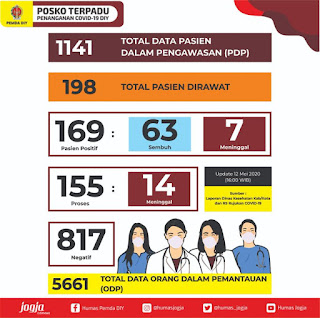Inflasi DIY Turun Drastis
YOGYAKARTA– Beban masyarakat Yogyakarta akibat impitan kenaikan harga kebutuhan pokok terkurangi. Hal ini berkaca dari rendahnya inflasi selama Februari yang hanya 0,1%.
Kini laju inflasi turun drastis dari bulan sebelumnya yang mencapai 0,84%. Kepala Badan Pusat Statistik (BPS) DIY Suharno mengungkapkan,melemahnya tingkat inflasi Yogyakarta lebih dikarenakan dua faktor utama.
Dua faktor yang dimaksud adalah terkendalinya permintaan masyarakat dan menurunnya harga sejumlah komoditas pokok seperti beras dan sayurmayur. Khusus beras mengalami penurunan harga hingga 3,38% dan memberi andil pelemahan inflasi sebesar 0,12%. ”Sementara untuk komoditas sayur-mayur, sebagian besar mengalami penurunan harga yang signifikan.Contohnya, cabai merah turun 20,25% dan tomat 42,39%,” katanya di Kantor BPS DIY,Jalan Lingkar Selatan Tamantirto, Kasihan, Bantul,Yogyakarta,kemarin.
Sementara itu, kenaikan indeks harga yang menjadi penyumbang inflasi terjadi pada enam kelompok pengeluaran. Enam kelompok tersebut yaitu makanan jadi,minuman,rokok dan tembakau yang naik 0,96%; perumahan, air, listrik, gas dan bahan bakar yang naik 0,43%; sandang naik 0,18%; kesehatan 0,62%; pendidikan, rekreasi dan olahraga naik 0,07%; serta transportasi, komunikasi dan jasa keuangan 0,13%. ”Dari sisi komoditas, yang naik di antaranya teh manis, tempe, ikan kranjang, minyak goreng, besi beton, nasi, sate, mi kering instan,upah pembantu rumah tangga dan batu bata,” ungkapnya. Secara umum,lanjut Suharno, meski Yogyakarta mengalami tren positif,masih tertinggal dari kota-kota lain. Dari 66 kota di Indonesia, 26 kota justru mengalami deflasi.
Deflasi tertinggi terjadi di Kota Medan sebesar 0,58% dan terkecil di Kota Pematang Siantar dengan 0,02%. Sebaliknya, inflasi tertinggi di Kota Tanjung Pinang yang mencapai 1,21% dan terendah di Pekanbaru 0,06%. ”Di Pulau Jawa,dari 23 kota, 13 kota mengalami inflasi dan 10 kota deflasi.Kota Tangerang dan Depok mengalami inflasi 0,47%. Untuk kota dengan deflasi tertinggi adalah Sumenep dengan 0,80%,” katanya.
Menanggapi penurunan inflasi ini, peneliti ekonomi madya Bank Indonesia Yogyakarta Djoko Raharto mengklaim sudah memprediksinya sejak awal Februari. Alasannya, dari sisi permintaan masyarakat terhadap berbagai komoditas sudah relatif normal. Sebaliknya dari sisi penawaran atau produksi sangat mencukupi.” Suplai komoditas utama seperti beras dari daerah lain juga berjalan lancar.Selain itu, nilai tukar rupiah juga mampu terapresiasi,” pungkasnya.
Harga Beras Turun, Jateng Deflasi 0,21%
Sementara itu, Provinsi Jateng pada Februari 2011 ini mengalami deflasi sebesar 0,21%. Hal ini didukung penurunan harga pada berbagai komoditas, utamanya komoditas cabai dan beras. Penurunan harga tersebut hampir merata terjadi di berbagai kota di Jateng. Deflasi juga terjadi pada sejumlah kota di Jateng. Misalnya,Surakarta,Semarang, dan Tegal.Hanya Kota Purwokerto saja yang mengalami inflasisebesar0,18%.
”Deflasidi Jateng memang cukup jelas sekali, apalagi di Surakarta itu deflasinya mencapai angka 0,66%,” ujar Kepala Badan Pusat Statistik (BPS) Jateng Lukito Praptoprijoko kemarin. Deflasi dipicu oleh penurunan harga pada berbagai komoditas pangan. Di antaranya cabai merah,cabai rawit,beras, daging ayam ras, dan pasir. Ini terlihat dari indeks perubahan harga pada komoditas tersebut. Beras misalnya, indeks perubahan harganya -3,1386%, kemudian komoditas cabai merah -18,2028%, cabai rawit - 5,5394%, daging ayam ras - 2,1422%, dan pasir -1,7235%. Khusus untuk komoditas beras, penurunan harga tersebut dipengaruhi oleh masa panen raya yang sekarang sedang berlangsung di Jateng.
Dan diperkirakan panen masih akan berlangsung hingga April 2011. Yang pasti dengan panen raya tersebut,pasokan beras di Jateng cukup melimpah. Sehingga harga beras pada berbagai daerah di provinsi ini mengalami penurunan. ” Di saat panen raya seperti sekarang ini memang produksinya jauh lebih besar dibandingkan kebutuhan sehingga pasti surplus. Namun oleh BPS surplus itu laporan tahunan, dan sebenarnya tiap waktu itu terus berubah,” katanya.Begitu juga cabai yang belakangan harganya sudah menurun karena produksinya sudah meningkat.
Sementara itu, Kepala Bidang Statistik Produksi BPS JatengHermantomengatakanangka ramalan (ARAM I) produksi padi di Jateng tahun ini diperkirakan sebesar 10,61 juta ton gabah kering giling (GKG).Jumlah itu naik 496.260 ton (4,91%) dibandingkan produksi 2010. Angka sementara produksi padi di Jateng 2010 lalu sebesar 10,11 juta ton GKG. arif budianto/ alkomari
DIY Inflation Down Drastically
YOGYAKARTA, Yogyakarta public expense due to press of rising prices of basic needs reduced. This is mirrored in the low inflation during February to just 0.1%.
Now the rate of inflation dropped from the previous month to reach 0.84%. Head of the Central Statistics Agency (BPS) revealed Suharno DIY, Yogyakarta further weakening of the inflation rate due to two main factors.
Two factors in question is the controlled public demand and declining prices of some essential commodities like rice and sayur mayur. Special price of rice has decreased to 3.38% and contributed to the weakening inflation of 0.12%. "As for commodity vegetables, most of the decreased prices signifikan. Example, red peppers and tomatoes down 20.25% 42.39%," he said at the BPS Office of DIY, Tamantirto South Ring Road, Pity, Bantul, Yogyakarta, yesterday.
Meanwhile, the rise in the price index is a contributor to inflation in the six groups of expenditure. Six groups of food, beverages, cigarettes and tobacco which rose 0.96%, housing, water, electricity, gas and fuel rose 0.43%; clothing gained 0.18%, 0.62% of health, education , recreation and sport rose 0.07%, as well as transportation, communications and financial services 0.13%. "In terms of commodities, which rose among them sweet tea, tempeh, fish kranjang, cooking oil, concrete iron, rice, satay, dried instant noodles, the wages of domestic servants and a brick," he said. In general, continued Suharno, although Yogyakarta experiencing a positive trend, still lag behind other cities. Of the 66 cities in Indonesia, 26 cities experienced a deflation.
The highest deflation occurred in the city of Medan at 0.58% and the smallest in the City Siantar by 0.02%. Conversely, the highest inflation in the city of Tanjung Pinang which reached 1.21% and 0.06% the lowest in Pekanbaru. "On the island of Java, from 23 cities, 13 cities and 10 cities experienced inflation deflasi. Kota Tangerang and Depok inflation 0.47%. For cities with the highest deflation is Sumenep by 0.80%, "he said.
Responding to the decline in inflation, economic researcher Associate Bank Indonesia Yogyakarta Djoko Raharto claimed to have predicted this since early February. The reason, in terms of public demand for various commodities was relatively normal. Instead of the supply side or production is insufficient. "Supply of major commodities such as rice from other regions are also running lancar.Selain, the rupiah is also able to appreciate," he concluded.
Rice prices down, Jateng Deflation 0.21%
Meanwhile, Central Java Province in February 2011 is experiencing deflation of 0.21%. This is supported on a variety of commodity price declines, especially chili and rice commodities. The price decline occurred almost evenly in various cities in Central Java. Deflation also occurs in several cities in Central Java. For example, Surakarta, Semarang, Purwokerto City and Tegal. only are experiencing inflasi among 0, 18%.
"Deflasi at Java is quite obvious, especially in Surakarta was deflasi reached 0.66%," said Head of the Central Statistics Agency (BPS) Lukito Praptoprijoko Central Java yesterday. Deflation triggered by the falling prices on various food commodities. Among the red chili, cayenne pepper, rice, chicken meat, and sand. This is evident from the index of price changes on commodities. Rice for example, the index of -3.1386% price changes, then commodity -18.2028% red pepper, cayenne pepper - 5.5394%, chicken meat - 2.1422%, -1.7235% and sand. Especially for commodities of rice, the price decline was influenced by the time of harvest is now underway in Central Java.
And the expected harvest will still last until April 2011. What is certain with the harvest, the supply of rice in Central Java is relatively abundant. So the price of rice in various regions in the province has decreased. "At harvest as current production is far greater than the requirement that it must have a surplus. But by the BPS annual reports surpluses, and in fact every time it is constantly changing, "katanya.Begitu also peppers the latter price has declined since its production has increased.
Meanwhile, Head of Production Statistics Jateng Hermanto said number BPS prediction (ARAM I) rice production in Central Java this year is estimated at 10.61 million tonnes of dry milled grain (MPD). The number is up 496,260 tons (4.91%) compared to 2010 production. Figure while rice production in Central Java in 2010 and 10.11 million tonnes of paddy.
Kini laju inflasi turun drastis dari bulan sebelumnya yang mencapai 0,84%. Kepala Badan Pusat Statistik (BPS) DIY Suharno mengungkapkan,melemahnya tingkat inflasi Yogyakarta lebih dikarenakan dua faktor utama.
Dua faktor yang dimaksud adalah terkendalinya permintaan masyarakat dan menurunnya harga sejumlah komoditas pokok seperti beras dan sayurmayur. Khusus beras mengalami penurunan harga hingga 3,38% dan memberi andil pelemahan inflasi sebesar 0,12%. ”Sementara untuk komoditas sayur-mayur, sebagian besar mengalami penurunan harga yang signifikan.Contohnya, cabai merah turun 20,25% dan tomat 42,39%,” katanya di Kantor BPS DIY,Jalan Lingkar Selatan Tamantirto, Kasihan, Bantul,Yogyakarta,kemarin.
Sementara itu, kenaikan indeks harga yang menjadi penyumbang inflasi terjadi pada enam kelompok pengeluaran. Enam kelompok tersebut yaitu makanan jadi,minuman,rokok dan tembakau yang naik 0,96%; perumahan, air, listrik, gas dan bahan bakar yang naik 0,43%; sandang naik 0,18%; kesehatan 0,62%; pendidikan, rekreasi dan olahraga naik 0,07%; serta transportasi, komunikasi dan jasa keuangan 0,13%. ”Dari sisi komoditas, yang naik di antaranya teh manis, tempe, ikan kranjang, minyak goreng, besi beton, nasi, sate, mi kering instan,upah pembantu rumah tangga dan batu bata,” ungkapnya. Secara umum,lanjut Suharno, meski Yogyakarta mengalami tren positif,masih tertinggal dari kota-kota lain. Dari 66 kota di Indonesia, 26 kota justru mengalami deflasi.
Deflasi tertinggi terjadi di Kota Medan sebesar 0,58% dan terkecil di Kota Pematang Siantar dengan 0,02%. Sebaliknya, inflasi tertinggi di Kota Tanjung Pinang yang mencapai 1,21% dan terendah di Pekanbaru 0,06%. ”Di Pulau Jawa,dari 23 kota, 13 kota mengalami inflasi dan 10 kota deflasi.Kota Tangerang dan Depok mengalami inflasi 0,47%. Untuk kota dengan deflasi tertinggi adalah Sumenep dengan 0,80%,” katanya.
Menanggapi penurunan inflasi ini, peneliti ekonomi madya Bank Indonesia Yogyakarta Djoko Raharto mengklaim sudah memprediksinya sejak awal Februari. Alasannya, dari sisi permintaan masyarakat terhadap berbagai komoditas sudah relatif normal. Sebaliknya dari sisi penawaran atau produksi sangat mencukupi.” Suplai komoditas utama seperti beras dari daerah lain juga berjalan lancar.Selain itu, nilai tukar rupiah juga mampu terapresiasi,” pungkasnya.
Harga Beras Turun, Jateng Deflasi 0,21%
Sementara itu, Provinsi Jateng pada Februari 2011 ini mengalami deflasi sebesar 0,21%. Hal ini didukung penurunan harga pada berbagai komoditas, utamanya komoditas cabai dan beras. Penurunan harga tersebut hampir merata terjadi di berbagai kota di Jateng. Deflasi juga terjadi pada sejumlah kota di Jateng. Misalnya,Surakarta,Semarang, dan Tegal.Hanya Kota Purwokerto saja yang mengalami inflasisebesar0,18%.
”Deflasidi Jateng memang cukup jelas sekali, apalagi di Surakarta itu deflasinya mencapai angka 0,66%,” ujar Kepala Badan Pusat Statistik (BPS) Jateng Lukito Praptoprijoko kemarin. Deflasi dipicu oleh penurunan harga pada berbagai komoditas pangan. Di antaranya cabai merah,cabai rawit,beras, daging ayam ras, dan pasir. Ini terlihat dari indeks perubahan harga pada komoditas tersebut. Beras misalnya, indeks perubahan harganya -3,1386%, kemudian komoditas cabai merah -18,2028%, cabai rawit - 5,5394%, daging ayam ras - 2,1422%, dan pasir -1,7235%. Khusus untuk komoditas beras, penurunan harga tersebut dipengaruhi oleh masa panen raya yang sekarang sedang berlangsung di Jateng.
Dan diperkirakan panen masih akan berlangsung hingga April 2011. Yang pasti dengan panen raya tersebut,pasokan beras di Jateng cukup melimpah. Sehingga harga beras pada berbagai daerah di provinsi ini mengalami penurunan. ” Di saat panen raya seperti sekarang ini memang produksinya jauh lebih besar dibandingkan kebutuhan sehingga pasti surplus. Namun oleh BPS surplus itu laporan tahunan, dan sebenarnya tiap waktu itu terus berubah,” katanya.Begitu juga cabai yang belakangan harganya sudah menurun karena produksinya sudah meningkat.
Sementara itu, Kepala Bidang Statistik Produksi BPS JatengHermantomengatakanangka ramalan (ARAM I) produksi padi di Jateng tahun ini diperkirakan sebesar 10,61 juta ton gabah kering giling (GKG).Jumlah itu naik 496.260 ton (4,91%) dibandingkan produksi 2010. Angka sementara produksi padi di Jateng 2010 lalu sebesar 10,11 juta ton GKG. arif budianto/ alkomari
DIY Inflation Down Drastically
YOGYAKARTA, Yogyakarta public expense due to press of rising prices of basic needs reduced. This is mirrored in the low inflation during February to just 0.1%.
Now the rate of inflation dropped from the previous month to reach 0.84%. Head of the Central Statistics Agency (BPS) revealed Suharno DIY, Yogyakarta further weakening of the inflation rate due to two main factors.
Two factors in question is the controlled public demand and declining prices of some essential commodities like rice and sayur mayur. Special price of rice has decreased to 3.38% and contributed to the weakening inflation of 0.12%. "As for commodity vegetables, most of the decreased prices signifikan. Example, red peppers and tomatoes down 20.25% 42.39%," he said at the BPS Office of DIY, Tamantirto South Ring Road, Pity, Bantul, Yogyakarta, yesterday.
Meanwhile, the rise in the price index is a contributor to inflation in the six groups of expenditure. Six groups of food, beverages, cigarettes and tobacco which rose 0.96%, housing, water, electricity, gas and fuel rose 0.43%; clothing gained 0.18%, 0.62% of health, education , recreation and sport rose 0.07%, as well as transportation, communications and financial services 0.13%. "In terms of commodities, which rose among them sweet tea, tempeh, fish kranjang, cooking oil, concrete iron, rice, satay, dried instant noodles, the wages of domestic servants and a brick," he said. In general, continued Suharno, although Yogyakarta experiencing a positive trend, still lag behind other cities. Of the 66 cities in Indonesia, 26 cities experienced a deflation.
The highest deflation occurred in the city of Medan at 0.58% and the smallest in the City Siantar by 0.02%. Conversely, the highest inflation in the city of Tanjung Pinang which reached 1.21% and 0.06% the lowest in Pekanbaru. "On the island of Java, from 23 cities, 13 cities and 10 cities experienced inflation deflasi. Kota Tangerang and Depok inflation 0.47%. For cities with the highest deflation is Sumenep by 0.80%, "he said.
Responding to the decline in inflation, economic researcher Associate Bank Indonesia Yogyakarta Djoko Raharto claimed to have predicted this since early February. The reason, in terms of public demand for various commodities was relatively normal. Instead of the supply side or production is insufficient. "Supply of major commodities such as rice from other regions are also running lancar.Selain, the rupiah is also able to appreciate," he concluded.
Rice prices down, Jateng Deflation 0.21%
Meanwhile, Central Java Province in February 2011 is experiencing deflation of 0.21%. This is supported on a variety of commodity price declines, especially chili and rice commodities. The price decline occurred almost evenly in various cities in Central Java. Deflation also occurs in several cities in Central Java. For example, Surakarta, Semarang, Purwokerto City and Tegal. only are experiencing inflasi among 0, 18%.
"Deflasi at Java is quite obvious, especially in Surakarta was deflasi reached 0.66%," said Head of the Central Statistics Agency (BPS) Lukito Praptoprijoko Central Java yesterday. Deflation triggered by the falling prices on various food commodities. Among the red chili, cayenne pepper, rice, chicken meat, and sand. This is evident from the index of price changes on commodities. Rice for example, the index of -3.1386% price changes, then commodity -18.2028% red pepper, cayenne pepper - 5.5394%, chicken meat - 2.1422%, -1.7235% and sand. Especially for commodities of rice, the price decline was influenced by the time of harvest is now underway in Central Java.
And the expected harvest will still last until April 2011. What is certain with the harvest, the supply of rice in Central Java is relatively abundant. So the price of rice in various regions in the province has decreased. "At harvest as current production is far greater than the requirement that it must have a surplus. But by the BPS annual reports surpluses, and in fact every time it is constantly changing, "katanya.Begitu also peppers the latter price has declined since its production has increased.
Meanwhile, Head of Production Statistics Jateng Hermanto said number BPS prediction (ARAM I) rice production in Central Java this year is estimated at 10.61 million tonnes of dry milled grain (MPD). The number is up 496,260 tons (4.91%) compared to 2010 production. Figure while rice production in Central Java in 2010 and 10.11 million tonnes of paddy.



Komentar
Posting Komentar